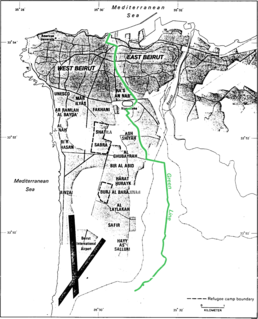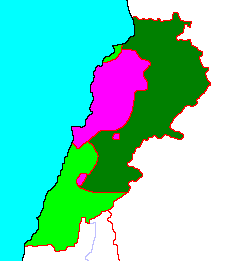 W
WThe Lebanese Civil War was a multifaceted civil war in Lebanon, lasting from 1975 to 1990 and resulting in an estimated 120,000 fatalities. As of 2012, approximately 76,000 people remain displaced within Lebanon. There was also an exodus of almost one million people from Lebanon as a result of the war.
 W
WThe 1982 Lebanon War, dubbed Operation Peace for Galilee by the Israeli government, later known in Israel as the Lebanon War or the First Lebanon War, and known in Lebanon as "the invasion", began on 6 June 1982, when the Israel Defense Forces (IDF) invaded southern Lebanon, after repeated attacks and counter-attacks between the Palestine Liberation Organization (PLO) operating in southern Lebanon and the IDF that had caused civilian casualties on both sides of the border. The military operation was launched after gunmen from Abu Nidal's organization attempted to assassinate Shlomo Argov, Israel's ambassador to the United Kingdom. Israeli Prime Minister Menachem Begin blamed Abu Nidal's enemy, the PLO, for the incident, and used the incident as a casus belli for the invasion.
 W
WThe Bab al-Tabbaneh–Jabal Mohsen conflict was a recurring conflict between Sunni Muslim residents of the Bab-al-Tibbaneh and Alawite Muslim residents of the Jabal Mohsen neighbourhoods of Tripoli, Lebanon. Residents of the two neighbourhoods have been rivals since the Lebanese Civil War, and have often engaged in violence. They are divided along sectarian lines, as well as by their opposition to or support of the Alawite-led Syrian government. Violence flared up during the Syrian Civil War spillover in Lebanon.
 W
WBourj el-Barajneh is a municipality located in the southern suburbs of Beirut, in Lebanon. The municipality lies between Beirut–Rafic Hariri International Airport and the town of Haret Hreik.
 W
WChildren of the Siege is a book by Pauline Cutting. It was first published in 1988 by William Heinemann.
 W
WEndless Night is a painting executed in 1983 by Nabil Kanso in oil paint on canvas measuring 2.25 by 3 metres. It is part of a group of related paintings made by Kanso in response to the Lebanese Civil War. The painting depicts the ravages war in a scene that "embodies recurrent themes of carnage, suffering and the disintegration of humanity."
 W
WFrom Beirut to Jerusalem (1989) is a book by American journalist Thomas L. Friedman chronicling his days as a reporter in Beirut during the Lebanese Civil War and in Jerusalem through the first year of the Intifada.
 W
WThe Good Fence was a term that referred to Israel's mountainous 80-mile northern border with Lebanon during the period following the 1978 South Lebanon conflict. At the time, southern Lebanon was controlled by the Maronite Christian militias and the South Lebanon Army, as the Free Lebanon State (1978-1984) and later the South Lebanon security belt administration.
 W
WThe Green Line was a line of demarcation in Beirut, Lebanon, during the Lebanese Civil War from 1975 to 1990. It separated the mainly Muslim factions in predominantly Muslim West Beirut from the predominantly Christian East Beirut controlled by the Lebanese Front. However, as the Civil War continued, it also came to separate Sunni from Shia. At the beginning of the Civil War, the division was not absolute as some Muslims lived East of the Green Line and some Christians lived in West Beirut; but, as the Civil War continued, each sector became more homogeneous as minorities left the sector they were in. The appellation refers to the coloration of the foliage that grew because the space was uninhabited. While most commonly referred to as the "Green Line", it was also sometimes called the "Demarcation Line". It generally stretched from the North of Beirut to the South, and the primary street that followed the Green Line was Damascus Street. There was no formal line or continual security but it was common to see militia checkpoints that people crossing at particular points had to go through and snipers on top of buildings were common. Many of the buildings along the Green Line were severely damaged or destroyed during the war. Since the end of hostilities, however, many of the buildings have been rebuilt within the framework of the urban renewal project of Solidere in Centre Ville.
 W
WLebanon is a mural size painting by Nabil Kanso depicting the Lebanese Civil War in a scene invoking the spirit and character of the people in the midst of horror and violence gripping the country. Amid the scene of chaos and devastation, two central figures reach across toward each other symbolically to represent the appeal for unity in defiance of the forces of division, destruction, and terror.
 W
WThe Multinational Force in Lebanon (MNF) was an international peacekeeping force created in August 1982 following an 1981 U.S.-brokered ceasefire between the PLO and Israel to end their involvement in the conflict between Lebanon's pro-government and pro-Syrian factions. The ceasefire held until June 3, 1982 when the Abu Nidal Organization attempted to assassinate Shlomo Argov, Israel's ambassador to London. Israel blamed the PLO and three days later invaded Lebanon. West Beirut was besieged for seven weeks before the PLO acceded to a new agreement for their withdrawal. The agreement provided for the deployment of a Multinational Force to assist the Lebanese Armed Forces in evacuating the PLO, Syrian forces and other foreign combatants involved in Lebanon's civil war.
 W
WThe Palestinian insurgency in South Lebanon was a conflict initiated by Palestinian militants based in South Lebanon upon Israel from 1968 and upon Christian Lebanese factions from the mid-1970s, which evolved into the wider Lebanese Civil War in 1975 and lasted until the expulsion of the Palestinian Liberation Organization from Lebanon in the 1982 Lebanon War. Although the PFLP-GC and some other Palestinian factions continued low-level military activities on Lebanese soil, after 1982 the conflict is considered to have faded in favor of local inter-Lebanese Mountain War and the Israel–Hezbollah conflict.
 W
WSatchit Shamsher Jung Bahadur Rana was the 34th Chief of Army Staff of the Royal Nepalese Army. He was a member of the Rana Dynasty of Nepal.
 W
WSyrian intervention in the Lebanese Civil War refers to military involvement of the Syrian Arab Army and other military and intelligence structures of the Ba'athist Syrian Arab Republic in the Lebanese Civil War. The involvement initiated in 1976, one year after the breakout of the Lebanese War, as Syrian military began supporting Maronite militias against the Palestinian Liberation Organization and leftist militias. Syria also raised a proxy militia of its own - the Palestine Liberation Army (PLA). The involvement was later legalized under the pretext of Arab Deterrent Force of the Arab League. Later, however, the stance changed, and Syria shifted support to Amal, while still backing certain Palestinian and Maronite militias. In 1982, Syria battled Israel over control of Lebanon.
 W
WThe United Nations Interim Force in Lebanon, or UNIFIL, is a UN-NATO peacekeeping mission established on 19 March 1978 by United Nations Security Council Resolutions 425 and 426, to confirm Israeli withdrawal from Lebanon which Israel had invaded five days prior, in order to ensure that the government of Lebanon would restore its effective authority in the area. The 1978 South Lebanon conflict came in the context of Palestinian insurgency in South Lebanon and the Lebanese Civil War.
 W
WUnited Nations Security Council Resolution 425, adopted on March 19, 1978, five days after the Israeli invasion of Lebanon in the context of Palestinian insurgency in South Lebanon and the Lebanese Civil War, called on Israel to withdraw immediately its forces from Lebanon and established the United Nations Interim Force In Lebanon (UNIFIL). It was adopted by 12 votes to none; Czechoslovakia and the Soviet Union abstained, and China did not participate.
 W
WUnited Nations Security Council Resolution 426, adopted on March 19, 1978, written the same day as resolution 425, approved of the Secretary-General's report on its implementation and in-turn established the United Nations Interim Force in Lebanon for 6 months, to continue operation thereafter if the Council so decides.
 W
WUnited Nations Security Council Resolution 427, adopted on May 3, 1978, after considering a letter by the Secretary-General, the council decided to increase the strength of the United Nations Interim Force in Lebanon (UNIFIL) from 4,000 to 6,000 troops.
 W
WUnited Nations Security Council Resolution 434, adopted on September 18, 1978, after reaffirming previous resolutions, including 425 (1978), 426 (1978) and 427 (1978), the Council commended the United Nations Interim Force in Lebanon for its work in Southern Lebanon, but expressed concern for the situation in Lebanon as a whole. The decision came in the context of the Lebanese Civil War and Palestinian insurgency in South Lebanon.
 W
WIn United Nations Security Council resolution 444, adopted on 19 January 1979, after recalling resolutions 425 (1978), 426 (1978), 427 (1978) and 434 (1978), and considering the report from the Secretary-General on the United Nations Interim Force in Lebanon (UNIFIL), the Council expressed its concern at the situation in Southern Lebanon and noted that UNIFIL had been unable to complete tasks at the end of its second mandate.